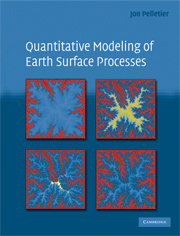Book contents
- Frontmatter
- Contents
- Preface
- Chapter 1 Introduction
- Chapter 2 The diffusion equation
- Chapter 3 Flow routing
- Chapter 4 The advection/wave equation
- Chapter 5 Flexural isostasy
- Chapter 6 Non-Newtonian flow equations
- Chapter 7 Instabilities
- Chapter 8 Stochastic processes
- Appendix 1 Codes for solving the diffusion equation
- Appendix 2 Codes for flow routing
- Appendix 3 Codes for solving the advection equation
- Appendix 4 Codes for solving the flexure equation
- Appendix 5 Codes for modeling non-Newtonian flows
- Appendix 6 Codes for modeling instabilities
- Appendix 7 Codes for modeling stochastic processes
- References
- Index
- Plate section
Chapter 7 - Instabilities
Published online by Cambridge University Press: 05 June 2012
- Frontmatter
- Contents
- Preface
- Chapter 1 Introduction
- Chapter 2 The diffusion equation
- Chapter 3 Flow routing
- Chapter 4 The advection/wave equation
- Chapter 5 Flexural isostasy
- Chapter 6 Non-Newtonian flow equations
- Chapter 7 Instabilities
- Chapter 8 Stochastic processes
- Appendix 1 Codes for solving the diffusion equation
- Appendix 2 Codes for flow routing
- Appendix 3 Codes for solving the advection equation
- Appendix 4 Codes for solving the flexure equation
- Appendix 5 Codes for modeling non-Newtonian flows
- Appendix 6 Codes for modeling instabilities
- Appendix 7 Codes for modeling stochastic processes
- References
- Index
- Plate section
Summary
Introduction
Many geomorphic processes involve positive feedbacks. The incision of a river valley into an undissected landscape is an example of a positive feedback process in which an incipient channel erodes its bed and expands its drainage area in a positive feedback. In some cases, positive-feedback processes give rise to landforms with no characteristic scale. Many drainage networks, for example, are branching networks with no characteristic scale above the scale that defines the hillslope-channel transition. In other cases, periodic landforms are created (Hallet, 1990). Sand dunes, for example, form by a positive feedback between the height of the dune, the deflection of air flow above it, and the resulting pattern of erosion and deposition (i.e. enhanced windward erosion and leeward deposition). Unstable geomorphic systems all include some type of positive feedback. In many arid alluvial channels, for example, sediment becomes stored preferentially at certain points along the channel profile, thereby causing the channel to aggrade and the channel bed to widen. Channel widening further enhances sediment storage and bed aggradation in a positive feedback. This instability continues until a sufficiently steep slope develops downstream of the aggrading zone, triggering channel entrenchment and narrowing. The positive feedback between channel width and localized erosion/deposition leads to spatial and temporal oscillations in arid alluvial channels. The study of instabilities does not involve any fundamentally new types of equations.
- Type
- Chapter
- Information
- Quantitative Modeling of Earth Surface Processes , pp. 161 - 187Publisher: Cambridge University PressPrint publication year: 2008

